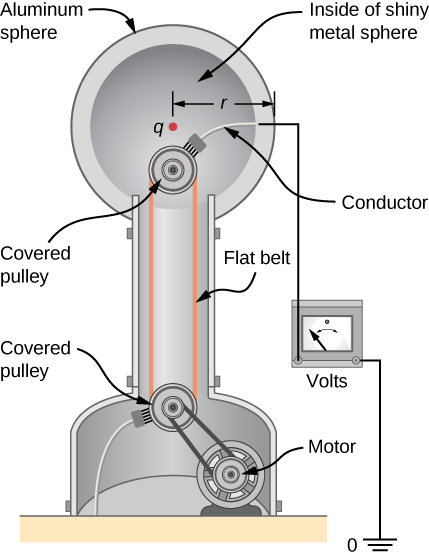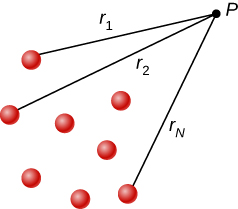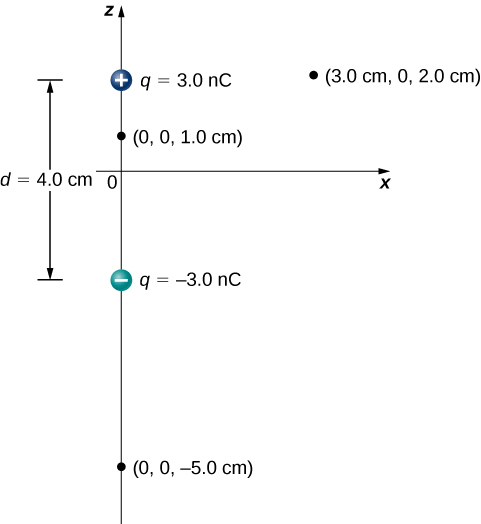3.6: Electric Potential of a Point Charge
( \newcommand{\kernel}{\mathrm{null}\,}\)
By the end of this section, you will be able to:
- Calculate the potential due to a point charge
- Calculate the potential of a system of multiple point charges
- Calculate the potential of a continuous charge distribution
Point charges, such as electrons, are among the fundamental building blocks of matter. Furthermore, spherical charge distributions (such as charge on a metal sphere) create external electric fields exactly like a point charge. The electric potential due to a point charge is, thus, a case we need to consider.
We can use calculus to find the work needed to move a test charge q from a large distance away to a distance of r from a point charge q. Noting the connection between work and potential W=−qΔV, as in the last section, we can obtain the following result.
The electric potential V of a point charge is given by
V=kqr⏟point charge
where k is a constant equal to 8.99×109N⋅m2/C2.
The potential in Equation ??? at infinity is chosen to be zero. Thus, V for a point charge decreases with distance, whereas →E for a point charge decreases with distance squared:
E=Fqt=kqr2
Recall that the electric potential V is a scalar and has no direction, whereas the electric field →E is a vector. To find the voltage due to a combination of point charges, you add the individual voltages as numbers. To find the total electric field, you must add the individual fields as vectors, taking magnitude and direction into account. This is consistent with the fact that V is closely associated with energy, a scalar, whereas →E is closely associated with force, a vector.
Charges in static electricity are typically in the nanocoulomb (nC) to microcoulomb (μC) range. What is the voltage 5.00 cm away from the center of a 1-cm-diameter solid metal sphere that has a –3.00-nC static charge?
Solution
PLAN
As we discussed in Common Models of Electric Field, charge on a metal sphere spreads out uniformly and produces a field like that of a point charge located at its center. Thus, by modeling the sphere as a point charge, we can find the voltage using the equation V=kqr.
SKETCH

Figure 3.6.1: A solid metal sphere of charge qwith a point P at a distance r from the center of the sphere. (CC-BY-SA 4.0, Ronald Kumon).
CALCULATE
Entering known values into the expression for the potential of a point charge (Equation ???), we obtain
V=kqr=(9.00×109N⋅m2/C2)(−3.00×10−9C5.00×10−2m)=−539V.
CHECK
The negative value for voltage means a positive charge would be attracted from a larger distance, since the potential is lower (more negative) than at larger distances. Conversely, a negative charge would be repelled, as expected.
A demonstration Van de Graaff generator has a 25.0-cm-diameter metal sphere that produces a voltage of 100 kV near its surface (Figure 3.6.2). What excess charge resides on the sphere? (Assume that each numerical value here is shown with three significant figures.)
Solution
PLAN
The potential on the surface is the same as that of a point charge at the center of the sphere, 12.5 cm away. (The radius of the sphere is 12.5 cm.) We can thus determine the excess charge using Equation ???
V=kqr.
SKETCH

CALCULATE
Solving for q and entering known values gives
q=rVk=(0.125m)(100×103V)8.99×109N⋅m2/C2=1.39×10−6C=1.39μC.
CHECK
This is a relatively small charge, but it produces a rather large voltage. We have another indication here that it is difficult to store isolated charges.
What is the potential inside the metal sphere in Example 3.6.1?
- Answer
-
V=kqr=(8.99×109N⋅m2/C2)(−3.00×10−9C5.00×10−3m)=−5390V
Recall that the electric field inside a conductor is zero. Hence, any path from a point on the surface to any point in the interior will have an integrand of zero when calculating the change in potential, and thus the potential in the interior of the sphere is identical to that on the surface.
The voltages in both of these examples could be measured with a meter that compares the measured potential with ground potential. Ground potential is often taken to be zero (instead of taking the potential at infinity to be zero). It is the potential difference between two points that is of importance, and very often there is a tacit assumption that some reference point, such as Earth or a very distant point, is at zero potential. As noted earlier, this is analogous to taking sea level as h=0 when considering gravitational potential energy Ug=mgh.
Systems of Multiple Point Charges
Just as the electric field obeys a superposition principle, so does the electric potential. Consider a system consisting of N charges q1,q2,...,qN. What is the net electric potential V at a space point P from these charges? Each of these charges is a source charge that produces its own electric potential at point P, independent of whatever other changes may be doing. Let V1,V2,...,VN be the electric potentials at P produced by the charges q1,q2,...,qN, respectively. Then, the net electric potential Vp at that point is equal to the sum of these individual electric potentials. You can easily show this by calculating the potential energy of a test charge when you bring the test charge from the reference point at infinity to point P:
Vp=V1+V2+...+VN=N∑1Vi.
Note that electric potential follows the same principle of superposition as electric field and electric potential energy. To show this more explicitly, note that a test charge qi at the point P in space has distances of r1,r2,...,rN from the N, charges fixed in space above, as shown in Figure 3.6.3. Using our formula for the potential of a point charge for each of these (assumed to be point) charges, we find that
Vp=N∑1kqiri=kN∑1qiri.
Therefore, the electric potential energy of the test charge is
Up=qtVp=qtkN∑1qiri, which is the same as the work to bring the test charge into the system, as found in the first section of the chapter.

An electric dipole is a system of two equal but opposite charges a fixed distance apart. This system is used to model many real-world systems, including atomic and molecular interactions. One of these systems is the water molecule, under certain circumstances. These circumstances are met inside a microwave oven, where electric fields with alternating directions make the water molecules change orientation. This vibration is the same as heat at the molecular level.
Consider the dipole in Figure 3.6.4 with the charge magnitude of q=3.0μC and separation distance d=4.0cm. What is the potential at the following locations in space? (a) (0, 0, 1.0 cm); (b) (0, 0, –5.0 cm); (c) (3.0 cm, 0, 2.0 cm).
Solution
PLAN
Apply Vp=k∑N1qiri to each of these three points.
SKETCH
We start by making a drawing showing a coordinate system, the charges, and the points where the potential is to be calculated.

As we go through the calculation of potential in the next step, we may draw in other items on the figure. For example, it may be useful to draw in dashed lines connecting the charges to the locations of interest when calculating the distance r between them.
CALCULATE
a. Vp=k∑N1qiri=(9.0×109N⋅m2/C2)(3.0 nC0.010m−3.0 nC0.030m)=1.8×103V
b. Vp=k∑N1qiri=(9.0×109N⋅m2/C2)(3.0 nC0.070m−3.0 nC0.030m)=−5.1×102V
c. Vp=k∑N1qiri=(9.0×109N⋅m2/C2)(3.0 nC0.030m−3.0 nC0.050m)=3.6×102V
CHECK
Note that evaluating potential is significantly simpler than electric field, due to potential being a scalar instead of a vector.
What is the potential on the x-axis? The z-axis?
- Answer
-
The x-axis the potential is zero, due to the equal and opposite charges the same distance from it. On the z-axis, we may superimpose the two potentials; we will find that for z>>d, again the potential goes to zero due to cancellation.

